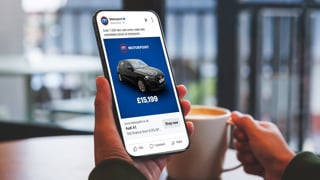To succeed at digital retail, dealers need to compliantly win consumers’ trust and offer an easy route to purchase.
1: Commit to it
There has never been a greater opportunity for dealers to start selling over the internet.
However, there is still work to do, according to iVendi’s recent report on online motor retailing, in which 57% of respondents believe motor retail lags behind the best online retail experiences. That’s borne out by the fact that 43% of dealers questioned said they plan to increase their online retail activity in the next 18 months, while 33% of manufacturers said they plan to offer the option to buy and finance a car online within the next 18 months.
“The main barriers to buying a car online related to the desire to see and test drive the car as well as the security aspect, while for financing a vehicle online the barriers related to confidence and security,” said James Tew, iVendi’s chief executive.
“The positive factors making consumers more likely to buy and finance a car online were seen to be ‘trust in brand’, followed by the lifestyle factors of a non-pressurised sale and convenience.”
Tony Patterson, director of automotive at e-commerce technology provider Summit, said: “The industry is still essentially a local-based industry, where you have your very expensive buildings and the whole of the business is oriented around that. It’s likely to include test drives, the handover experience and everything else. Against that background, you have the customer, who expects the ultimate choice. They don’t really care where the vehicle is and they expect more choice and more democracy in how they choose.”
Patterson added: “Online is a very effective way to take a local proposition and amplify it nationally… Online is where it’s at.”
2: Win consumers’ trust
The trust and relationship that good salespeople create when face to face with customers has to be mirrored by the online sales operation. That starts with clarity and honesty – digital marketing and website content, including images and videos, must provide consumers with the detail they desire.
Shaun Harris, sales director at Codeweavers, said dealers need to make the process easier and to build a greater trust with the customer. That is done by reviewing the information provided on their website, the brand’s personality and tone of voice, and quality of aftercare such as extended warranties, he said.
Darren Williams, director at Elements PRMC, said that when presenting a vehicle online dealers need to focus on improving their search facility for the customer and providing them with a personal presentation after an enquiry.
It’s also key for dealers to provide accurate and complete information, ensuring every aspect of the vehicle, including function, aesthetics and technical details, is covered. Dealers can also use tools, such as the vehicle condition report traditionally used by car hire companies to flag any obvious defects to the customer.
When it comes to communication, Williams said the method of response should fit the nature of the enquiry, and should also be done in a timely manner. While one-to-one dialogue can help to build a rapport and trust with the customer, he said there’s nothing more irritating than being called back when all you want is a simple response to an online query.
“As far as the tools available, anything that engages is a good thing, but a word of caution – ensure your staff are properly trained in how to use them and their behaviour, language and conduct is appropriate,” he said. “These must have synergy with your own brand values.”
3: Know the law
Although commonly referred to as the Distance Selling Regulations, the name of the legislation that covers distance selling is The Consumer Contracts (Information, Cancellation and Additional Charges) Regulations 2013. This has been in force since June 2014 and like many of the UK’s current laws, it is based on an EU directive, in this case the consumer rights directive.
The Consumer Contracts Regulations define three different types of contract between a trader and a consumer. A distance contract, an off-premises contract and an on-premises contract. In the scenario where there is no face-to-face contact between the dealer and buyer, it would be covered as being a distance contract.
“If a dealer advertises on their website that customers can call up, pay a deposit either over the phone or online and then get the vehicle delivered, that is almost certainly an organised distance sales scheme. As such, all the distance sales rules will apply,” said Nona Bowkis, solicitor at Lawgistics.
Distance sales give the customer 14 days to effectively change their mind, but they also require dealers to provide the customer with paperwork advising them of their rights. The cancellation period starts when the consumer has received both the goods and the paperwork.
Failure to do so would mean that, legally, the 14-day ‘change your mind’ period can be extended for up to one year.
Bowkis said: “The customer normally has to pay the cost of the vehicle being returned and a clause stating this should be included in the cancellation paperwork.”
4: Give the next best thing to a test drive
Many dealers consider video presentations to be particularly effective when demonstrating a car to an online customer.
Tew said: “Effectively what you are trying to do is to create an artificial test drive.
“Now you can send them a personalised video of the car from anywhere in the country, so that they can see it for themselves. The challenge for the dealer, however, is that when video becomes the norm they will have to move to the next level of digital delivery, whatever that is.”
Škoda, for example, has a central team of product hosts that use static and handheld cameras to display its range and to answer questions from online browsers.
Tew added that dealers need to take as many high-quality images of the vehicle from as many different angles as possible, both inside and outside, covering the full inventory and metadata descriptions where necessary. He added that improvements in quality of images in recent years as well as the use of 360-degree interior and exterior imaging have helped the dealer to boost sales.
“Being able to zoom in and see certain parts of the vehicle is key,” he said. “I certainly think there is a correlation between the number of images of a vehicle that are viewed by a customer and purchasing that model.”
Dermot Kelleher, marketing and business intelligence director for Motors.co.uk, said faster broadband speeds are enabling online vehicle retailing. “Undoubtedly, imagery and video are probably the two key drivers of why dealers now feel like they can put a car out there that will be able to give a good consumer experience without that consumer actually having to touch it,” he said.
5: Finance and compliance
An inability to complete finance agreements online has been a barrier, but that is now being overcome, as finance houses such as Black Horse and Barclays Partner Finance roll out electronic signing and APIs that will link the dealer’s online customer to their own secure portal for their finance application and affordability checks.
Tew said dealers should bring finance into the buying process at the earliest opportunity so the customer can view the different payment options available to them and then match that to their chosen vehicle.
The incorporation of finance calculators on dealers’ websites has become commonplace, but dealers cannot delegate all FCA compliance to the consumer. The FCA also stipulates that a car dealer’s financial promotions and adverts must be fair, clear and not misleading.
Spencer Halil, director of Alphera Financial Services UK, said dealers need to present their range of finance products simply and transparently, through FAQs, comparison tables and descriptive explanations or videos, to allow the customer to make their own decision.
“The critical point is that there should be no bias or agenda in the explanations – let the customer choose what is right for them, not what works best for the dealer or lender,” he said.
Tom Seymour, Craig Thomas and Alex Wright



















Login to comment
Comments
No comments have been made yet.